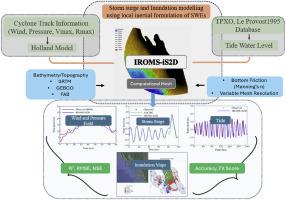一种计算效率高的模拟风暴潮和海岸淹没的局部惯性模式
IF 4.6
2区 环境科学与生态学
Q1 COMPUTER SCIENCE, INTERDISCIPLINARY APPLICATIONS
引用次数: 0
摘要
热带气旋通过风暴潮和淹没给低洼沿海地区带来重大风险,因此数值模拟对灾害规划和疏散至关重要。本研究介绍了IROMS-iS2D(综合河海建模系统-惯性风暴潮2D),这是一种新颖的局部惯性2D模型,可以在非结构化网格的单一框架内模拟风暴潮和淹没。与现有依赖外部浪涌输入或受结构化网格约束的局部惯性模型不同,IROMS-iS2D动态模拟风暴潮和随后的淹没。与2D浅水模型相比,它实现了10-15倍的加速,同时支持高分辨率网格(30-200米)。气旋强迫来自JTWC/IMD使用荷兰模式的最佳跟踪,确保实际的浪涌输入。利用INCOIS数据验证了IROMS-iS2D对孟加拉湾气旋的预测,结果吻合良好(R2 >0.9, RMSE≈0.2 m, NSE >0.9)。在气旋Mocha中,Sentinel-1验证显示4359 km2的淹没面积,准确率为79.6%,f1得分为61.7%,显示了实时洪水预报的潜力。本文章由计算机程序翻译,如有差异,请以英文原文为准。

A computationally efficient local-inertial model for simulating storm surges and coastal inundation
Tropical cyclones pose significant risks to low-lying coastal regions through storm surges and inundation, making numerical modelling crucial for disaster planning and evacuation. This study introduces IROMS-iS2D (Integrated River Ocean Modelling System-Inertial Surge 2D), a novel local-inertial 2D model that simulates storm surge and inundation within a single framework on unstructured grids. Unlike existing local-inertial models that rely on external surge inputs or constrained by structured grids, IROMS-iS2D dynamically simulates storm surges and subsequent inundation. It achieves a 10–15 times speedup over 2D shallow water models while supporting high-resolution grids (30–200 m). Cyclone forcing is derived from JTWC/IMD best-tracks using the Holland model, ensuring realistic surge inputs. IROMS-iS2D was validated for Bay of Bengal cyclones using INCOIS data, showing good agreement (R2 > 0.9, RMSE ≈ 0.2 m, NSE >0.9). For Cyclone Mocha, Sentinel-1 validation showed 4359 km2 inundation with 79.6 % accuracy and an F1-score of 61.7 %, demonstrating potential for real-time flood forecasting.
求助全文
通过发布文献求助,成功后即可免费获取论文全文。
去求助
来源期刊

Environmental Modelling & Software
工程技术-工程:环境
CiteScore
9.30
自引率
8.20%
发文量
241
审稿时长
60 days
期刊介绍:
Environmental Modelling & Software publishes contributions, in the form of research articles, reviews and short communications, on recent advances in environmental modelling and/or software. The aim is to improve our capacity to represent, understand, predict or manage the behaviour of environmental systems at all practical scales, and to communicate those improvements to a wide scientific and professional audience.
 求助内容:
求助内容: 应助结果提醒方式:
应助结果提醒方式:


